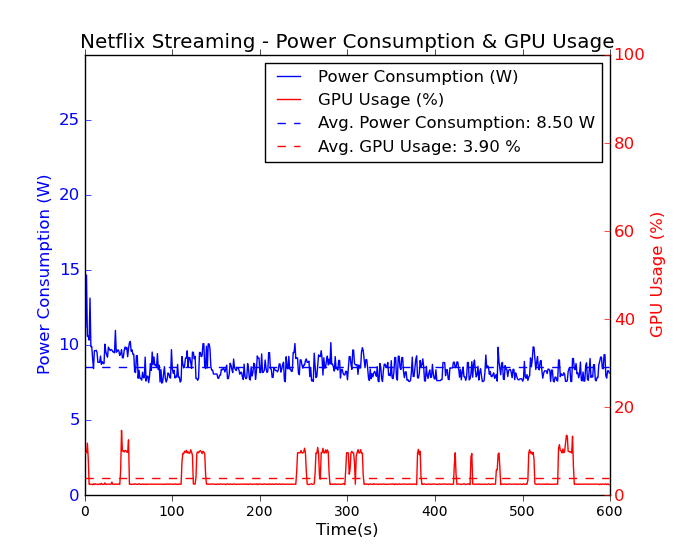Intel's Haswell NUC: D54250WYK UCFF PC Review
by Ganesh T S on January 3, 2014 4:25 PM ESTNetworking Performance and Streaming Aspects
In this section, we will take a look at the networking capabilities of the unit and also our standard HTPC streaming tests (involving YouTube and Netflix). Starting with this review, we are standardizing our evaluation of the wireless networking capabilities of UCFF and industrial PCs. Our standard test router is the Netgear R7000 Nighthawk configured with both 2.4 GHz and 5 GHz networks. The router is placed approximately 20 ft. away, separated by a drywall (as in typical US buildings). A wired client (Zotac ID89-Plus) is connected to the R7000 and serves as one endpoint for jPerf evaluation. The UCFF PC is made to connect to the two wireless SSIDs and jPerf tests are conducted for both TCP and UDP transfers with pre-set transfer parameters.
In our NUC build, Intel's Dual-Band Wireless-7260 delivers 2T2R 802.11ac speeds and provides very good throughput numbers when used with an appropriate router. As the gallery below shows, the 2.4 GHz band is able to deliver TCP throughput in the region of 86 Mbps and UDP throughput in the region of 96 Mbps.
The theoretical bandwidth number for 2x2 802.11ac is 867 Mbps. Practically, in the 5 GHz band, the 7260's TCP throughput is around 210 Mbps and UDP throughput is around 239 Mbps in our test setup.
Network Streaming Performance - Netflix and YouTube
YouTube and Netflix are two very popular streaming services utilized on HTPCs. With Windows 8, Silverlight is no longer necessary for Netflix streaming. The Netflix app on Windows 8 supports high definition streams (up to 5.8 Mbps) as well as 5.1-channel Dolby Digital Plus audio on selected titles.
It is not immediately evident whether GPU acceleration is available or not from the OSD messages. However, GPU-Z reported an average GPU utilization of 4% throughout the time that the Netflix app was playing back video. The average power consumption was around 8.5 W. Coming it at less than 10 W for the whole system while streaming HD video is very impressive. The spikes in the GPU usage were observed whenever the subtitles or control OSD kicked in. There is obviously some correlation between these spikes and the recorder power consumption at the wall.
One of the issues that I faced with the Netflix app was that bitstreaming HD audio (Dolby Digital Plus) would just not work. The playback was jerky to the point of being unwatchable and with either no or intermittent audio output to the AV receiver. Apparently, this is an issue faced by multiple users, and the problem stems from the Intel Display Audio Driver. Intel's rep on the forums, however, has been unable to reproduce the issue. So, it looks like many users are being left high and dry, unable to take advantage of one of the most important aspects of running Netflix as a Metro app.
Unlike Silverlight, Adobe Flash continues to maintain some relevance right now. YouTube continues to use Adobe Flash to serve FLV (at SD resolutions) and MP4 (at both SD and HD resolutions) streams. YouTube's debug OSD indicates whether hardware acceleration is being used or not.
Despite Windows 8 having plenty of YouTube apps, the browser interface is pretty much functional and free of external intrusive ads. The graph below shows the power consumption and GPU loading when playing a YouTube video in full screen using the Adobe Flash plugin on Mozilla Firefox.
The average GPU load is pretty constant around 8%, but power consumption at the wall has spikes corresponding to bursts of network activity. These bursts die down towards the end, after the full video gets buffered.
We saw that Haswell provided great power benefits for such network streaming activities in our HTPC piece at launch time. The Intel NUC takes this power benefit one step further by using a ULV processor. With a power consumption of less than 10 W for these activities, we are approaching dedicated media streamers' territory with the added flexibility of a full-blown PC at one's disposal.




















107 Comments
View All Comments
chrnochime - Sunday, January 5, 2014 - link
Well if you can kindly point us to an arm equipped device similar in size, with the same kind of ports, that actually runs win8 and is available, by all means post the link. Until then, you can hypothetically speaking all you want.lhl - Friday, January 17, 2014 - link
Yeah, I'm going to need to call BS on that. I assume that you haven't actually tried using those ARM SoC boards. I've tested most of the "high performance" ones (ODROID-X2 (Exynos 4), Samsung Chromebook (Exynos 5), Wandboard and UDOO (i.MX6 Quad)) w/ Ubuntu. First of all, cost on those are ~$150 w/ cases/power etc, so far from 1/5th the price (that's w/ soldered-in not-enough RAM and no storage). And second, the performance and software compatibility (anything from uBoot issues, to X11 drivers, to Flash Player) make them far less than ideal for general purpose usage.The ARM SoCs make for great embedded boards - TDP is great and the IPU/VPU on the i.MX6 is really interesting, but a good experience for Jane User? No way.
For general computing work, the i5 may be overkill, but a 1037u BRIX retails for $170 (+$40 for a 4GB SODIMM) which is probably where I'd start.
misfit410 - Tuesday, January 28, 2014 - link
After trying the Steam In Home Streaming beta, I think the market for such machines as a secondary gaming station for PC gamers will increase.. if you have a solid gaming machine on the same network, this is all you'd need for playing those games on your TV at full fidelity.asliarun - Friday, January 3, 2014 - link
AT and Ganesh, thanks once again for an excellent review. I have a couple of questions and a suggestion:Q1. I am planning to build an audio server (optical or usb out from the PC - feeding to the rest of my stereo chain - Audio GD DAC acting as a DAC and preamp, Parasound power amp, and floorstanders). The NUC seems to be the ideal form factor for an audio server. Do you have any thoughts on this? Do you test audio quality (specifically stereo - not gaming audio) during your review and tests? I'm actually not planning to use the DAC of the onboard sound so that actually would not be an issue for me.
Q2. Another option I have been mulling over is to build a multi-purpose "steam box" kind of a device - that will let me run this SFF PC as an audio server, as an HTPC with XBMC, and will also let me do light to mid-level gaming with Steam big picture. I was actually waiting for Kaveri which I think will actually be more viable - but am not sure how well Haswell's integrated graphics stand up with something like Kaveri or even a graphics card. Especially with thermals and throttling in mind. What are your thoughts on the viability of the NUC in this regard? Do you have any pointers on what one should look at - considering that it should also be a small form factor (shoebox size)?
S1: This might sound silly, but can you please post pictures of the cabinets and boxes with some other object in the picture as well - to give us a visual perspective of how big/small it is? I see so many pictures of mini ITX cabinets and other HTPC cabinets, but almost all of them lack the size perspective. Looking at the pictures, I have no way to visually judge if it will fit in my media cabinet at all. I have to look at the dimensions every time and it is painful. For example, you could post a picture of the cabinet with a picture of an iPad alongside.
Alketi - Friday, January 3, 2014 - link
It's a 4.5" square and 1.5" tall. It's TINY.asliarun - Friday, January 3, 2014 - link
Thanks. Wow, that is tiny indeed. Slightly OT - I have a Minix Neo X5 which has somewhat similar dimensions and is also fanless. It is actually quite a credible audio (and average quality video) server. However, being on the Android platform and based on some Rokchip version, the lack of software support is frustrating. For example, I wanted to install LMS (Logitech Media Server) so that I can serve audio to my Squeezebox. However, there is no port of LMS to Android that I know of.Maybe, I should wait for the Silvermont version of NUC. It is supposed to release in the next couple of months. It can act as a fully fanless audio server. On second thoughts, having gaming expectations from this small a device is not a great idea.
Alketi - Saturday, January 4, 2014 - link
I have the i3 Haswell NUC and use it solely as an XBMC server via OpenELEC. I leave it on all the time, with XBMC set to turn off its display after X minutes. I measured 6W idle on mine, which nicely matches Ganesh's findings.And sitting 8-10 feet away, I can't hear the fan at all. It's probably OFF when idling at 6W, and I still hear nothing during a movie (the quiet parts), as the NUC only pulls 13W when playing 1080P video.
I'm very happy.
ShieTar - Saturday, January 4, 2014 - link
There are already fanless mods of the current NUC, see for example http://tinyurl.com/p9vq9qmasliarun - Saturday, January 4, 2014 - link
I have been following fanlesstech for a while. They have written about some very interesting fanless cases. A surprising number of them are for the NUC.http://www.fanlesstech.com/
There's stuff from Habey, Streacom and the like. But also some exotic ones - very good eye candy.
This one is my favourite for example: http://htpc.jp/u3/index.html
Personally, I believe that a Bay Trail (especially Bay Trail D) / Silvermont based system is the best fit for a NUC form factor. We could build a very viable system for well under $500, with a system draw in the 10W-15W range that can give us a fully fanless system if we wanted to, and will still have the same horsepower as a Core2Duo system (Bay Trail D). I feel that Haswell is a wrong choice from a cost, heat, and noise perspective.
Here's an example: http://www.fanlesstech.com/2013/12/very-first-bay-...
The only open question is if these Bay Trail based HTPC systems will be capable of full blown HTPC duty. I would think so based on technical specs but real world is another thing entirely.
Maybe Anandtech could do a review?? :)
Wixman666 - Saturday, January 4, 2014 - link
I believe that the Haswell family is a better solution overall. The on die Intel 5000 video is GREAT. Even though the Bay Trail looks decent, it isn't as well-rounded.